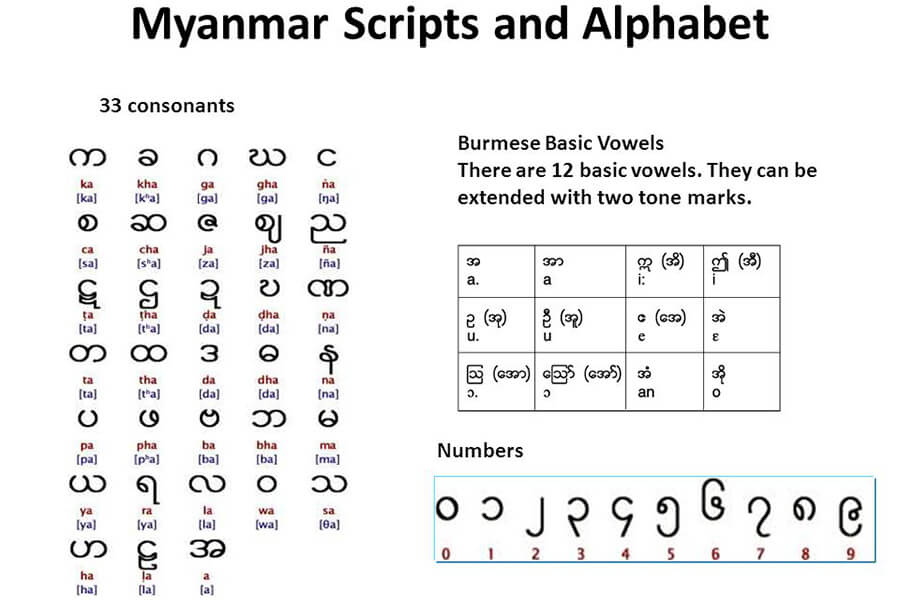When joining Myanmar tours, travelers are often fascinated not only by the country’s golden pagodas and serene landscapes but also by its unique writing system—the Myanmar alphabet. This script, with its rounded shapes and flowing style, is more than just a tool for communication; it is a reflection of Myanmar’s culture and history. Learning how to write the Myanmar alphabet opens a doorway into the language, making the journey through this enchanting land even more meaningful.
Introduction to the Myanmar Alphabet
When I first stumbled upon the Burma alphabet during my backpacking trip through Southeast Asia a few years ago, it looked like a beautiful puzzle of swirling circles and curves. I was in Yangon, sipping tea at a local market, and the signs around me were alive with these elegant scripts that seemed to dance on the page. The Myanmar writing system, also known as the Burmese script, is an abugida—a fancy term for a system where consonants carry an inherent vowel sound, and additional marks tweak those vowels. It's used primarily for the Burmese language, spoken by millions in Myanmar, and it's what makes reading a menu or a street sign feel like unlocking a secret code.
What struck me most was how deeply the Myanmar alphabet is woven into everyday life and culture. From ancient temple inscriptions to modern billboards, it's not just a tool for communication but a symbol of identity. During my stay, I saw monks chanting scriptures in this script, and families scribbling notes on palm leaves—echoing traditions that have lasted centuries. Learning even a bit of the Myanmar alphabet opened doors for me, like bargaining at markets or understanding song lyrics. It's more than letters; it's a bridge to Myanmar's rich heritage, blending spirituality, history, and daily chatter in a way that made my travels unforgettable.
Origins and Structure of the Myanmar Alphabet
Diving deeper into the Burma alphabet felt like time-traveling. I recall sitting in a quiet library in Mandalay, flipping through old books, and discovering its roots trace back to the ancient Brahmi script from India, around the 3rd century BCE. Over time, it evolved through influences from the Mon people and Pali language, adapting into the rounded forms we see today. This transformation happened because early writers used palm leaves, where straight lines could tear the material—hence the curvy, bubble-like letters that give the Myanmar alphabet its distinctive charm.
Structurally, the Myanmar alphabet has 33 consonants and 12 vowel symbols, but it's not a straightforward alphabet like English. As an abugida, each consonant comes with a built-in 'a' sound, and vowels are added as diacritical marks above, below, or around them. I counted them out one afternoon: consonants like 'ka' (က), 'kha' (ခ), up to 'ha' (ဟ). Vowels twist things up, creating syllables that stack in creative ways. Compared to other Asian scripts, like Thai or Khmer, the Myanmar alphabet stands out with its lack of spaces between words—everything flows in a continuous stream, which initially baffled me. It's more compact than Devanagari (used in Hindi) and has fewer tones than Vietnamese, but its phonetic depth captures the nuances of Burmese speech beautifully. Exploring this made me appreciate how scripts evolve to fit a culture's needs, turning simple marks into a living legacy.
How to Write Myanmar Alphabet
Consonants
- Ka (က)
- Begin with a small circle on the right side.
- Curve leftward in one smooth motion.
- Think of it as drawing a bubble with a tail.
- Kha (ခ)
- Start the same way as Ka.
- Add a hook or downward stroke below to distinguish it.
- Nga (င)
- Begin with a rounded circle at the base.
- Extend into a gentle curve upwards.
- Practice keeping the curve smooth (easy to turn into a messy squiggle!).
Vowels (attach to consonants)
- i (ကိ = ki)
- Add a short mark above the consonant.
- Always placed at the top, like a small accent.
- u (ကု = ku)
- Add a mark underneath the consonant.
- Looks like a tiny hook below the circle base.
- e (ကေ = ke)
- Place a curve or stroke in front of the consonant.
- Think of it as a prefix to the circle shape.
- o (ကို = ko)
- Combination of marks: front (like "e") + below (like "u").
- Shows how Myanmar script stacks vowels creatively.
Pronunciation Guide for the Myanmar Alphabet
Learning the pronunciation of the Myanmar alphabet is just as important as mastering how to write it. Unlike English, Burmese sounds are syllable-based and rely on clear vowel–consonant combinations. Each letter represents a consonant, and vowels attach to modify the sound.
Consonant Pronunciation Basics
Ka (က) → pronounced like “k” in sky (unaspirated).
Kha (ခ) → similar to “k” in kite, but with a strong burst of air (aspirated).
Nga (င) → sounds like “ng” in sing, but it can also appear at the start of a word.
Sa (စ) → a soft “s,” close to sun.
Ma (မ) → “m” as in man.
Ba (ဗ) → “b” as in bat, often softer depending on context.
Vowel Pronunciation
a (အ) → short “ah” sound, like in father.
i (အိ) → “ee” sound, like in see.
u (အု) → “oo” sound, like in food.
e (အေ) → long “ay,” like in say.
o (အို) → rounded “oh,” as in go.
Key Features to Remember
Tones matter: Burmese is a tonal language with at least three main tones (high, low, creaky). The same syllable can mean different things depending on pitch.
No final consonant clusters: Unlike English, Burmese syllables usually end with a vowel or a soft nasal sound.
Smooth flow: Pronunciation is gentle and rounded, matching the circular nature of the script.




